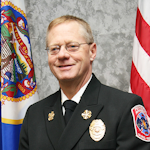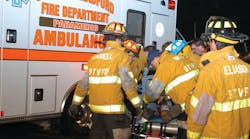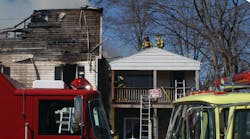20 Tough Questions For the Fire Chief: Are You Prepared To Answer Them? Question 14
Essentially, there are two types of medical transportation – emergency (EMS) and non-emergency (transport service). This month’s question revolves around non-emergency medical transportation. Many privately run and hospital-based medical transportation operations provide both types of service. While it is far less common, some fire-based EMS providers also provide routine, non-emergency transportation.
From a strictly financial perspective, non-emergency services tend to be more lucrative because a patient can be pre-qualified for payment and matters of reimbursement and insurance can be worked out in advance of the trip. This is vastly different from emergency medical transportation, where service is the first priority regardless of the patient’s ability to pay. The former lets the transporting entity ensure payment in advance. The latter has no assurance of payment for services.
This article reviews factors for fire-EMS departments to review when considering non-emergency transport.
• Generating revenue. The amount of revenue that can be generated may be difficult to estimate and is a function of many variables. Factors influencing reimbursement include: the age and demographic of the population; the number of residents who are privately insured; the number of residents who have Medicare, supplemented with private insurance; the number of residents who have Medicare with no private insurance supplement; the number of nursing homes and extended-care facilities in the jurisdiction; the presence (or absence) of facilities that provide ongoing medical services (e.g., kidney dialysis and cancer treatment centers); and the presence or absence of competition for private transportation service.
• Staffing. One benefit of scheduled non-emergency transportation is that the personnel needed to provide the services are based on scheduled demand and therefore staffing is far more predictable. Non-emergency transports also tend to serve non-critical patients, so crews may not be required to hold higher levels of medical certification like their counterparts on the emergency side of the transportation business.
One potential deterrent to providing non-emergency transport is staffing shortages for emergencies if the on-duty ready-response crew staffs transport vehicles. This must be evaluated closely. A community does not want to suffer a loss as a result of on-duty emergency response personnel being committed to a non-emergency, revenue-generating activity. This may lead to public criticism and would likely impact the morale of the emergency responders.
• Local vs. long-distance transports. Another consideration when providing non-emergency transport is the reach of the service provided. A decision must be made whether non-emergency transports will be strictly local or if the department will also do long-distance transports and, if so, what is the geographic range for the services. Depending on the location of the jurisdiction in relation to specialty care centers, the number of long-distance transport opportunities can be substantial. For example, a small-town hospital may not have specialty trauma, burn, cardiac, cancer, neurological, orthopedic, pediatric and/or geriatric care available and patients needing this care may need transportation to and from facilities hundreds of miles away. If patients are not ambulatory or their comfort is hindered by long-distance transport by private vehicle, a non-emergency ambulance ride may serve them well.
Sometimes, the transport personnel wait for patients to receive scheduled treatments and then return them to their originating facility (or home). While the waiting time may be billable, it does take personnel out of service for longer, and sometimes unpredictable, amounts of time.
• Workload management. As communities seek ways to obtain higher unit utilization (i.e., less down time) for fire department personnel, non-emergency transportation may be looked at as an additional service that can generate revenue. This may appeal to elected and appointed officials because revenue above the cost of providing transports may be used to help pay the expense of running the emergency operations.
A word of caution is in order when evaluating unit utilization for emergency response personnel. The high-stress/high-demand nature of providing emergency services can take a toll on responders and down time is important so the responders can rest their bodies and their minds. Fatigue impacts work performance and the quality of decision-making. In emergency services, responders may only get one opportunity to get it right and the consequences of error can be catastrophic.
• Competition. Presumably, private entities are providing non-emergency transport services in any jurisdiction. As the fire department enters this market, private providers feeling the strain of competition may complain that government is encroaching on the private sector and, furthermore, the public provider has a financial advantage because the operation is being subsidized by taxpayer dollars. To compete with private entities is a policy discussion and decision for the elected officials.
•The role of government. This applies to the role of government as a provider of services. If a fire department provides non-emergency transportation, is it providing a service that meets the essential needs of citizens or is it providing a service to generate revenue (i.e., for profit)? Where would the line be drawn? Could the police department start competing with private entities to provide security at facilities? Could the public works department start plowing the snow from the parking lots of businesses or private driveways?
As the economy has made a fundamental shift that will be slow to return (if it returns at all), government is feeling strained to reduce costs or enhance revenues. Non-emergency transportation services may be a viable option.
Richard Gasaway will present “Fireground Command Decision Making and Situational Awareness” at Firehouse Expo 2013, July 23-27 in Baltimore, MD.
RICHARD B. GASAWAY, Ph.D., has served for more than 30 years in public safety, including 22 years as a chief fire officer. He holds bachelor’s, master’s and doctor of philosophy degrees in finance, economics, business administration and leadership. Dr. Gasaway operates the Situational Awareness Matters! website (www.SAMatters.com). He provides programs on firefighter safety and leadership to departments throughout the United States and Canada. Dr. Gasaway also hosts the Leader’s Toolbox podcast radio show on Firehouse.com. RICHARD C. KLINE has been the fire chief for the City of Plymouth, MN, since 1992 and is a senior associate at the Gasaway Consulting Group. He holds a master’s degree in public safety and is a credentialed chief fire officer through the Commission on Public Safety Excellence. Kline is the chairman of the Minnesota State Fire Chief Association’s Safety and Health Committee. The authors can be reached at: [email protected] or 612-548-4424.

Richard Kline
RICHARD C. KLINE is a 40-year fire service veteran who recently retired from the Plymouth, MN, Fire Department, following 23 years of service as fire chief. He is a frequent regional and national speaker who covers topics that relate to command competencies and firefighter safety and health. Kline can be contacted at [email protected].









